Features of the Field of Internal Waves on the Abkhazian Shelf of the Black Sea according to Remote Sensing Data and In Situ Measurements
Abstract
:1. Introduction
2. Methods for Measuring and Processing the Obtained Data
3. Concentric Structures near the Mouth of the Kodor River
4. Internal Waves Generated by the Plume of the Kodor River
5. Cyclonic Eddy Near Cape Sukhumsky and Internal Waves That It Generated
6. Generation of Internal Wave Packets Associated with a Plume of River Waters and Decay of Inertial Waves in the Galsky Region
7. Conclusions
- It is shown that internal waves are widespread on the Abkhazian shelf. They appear as trains of short-period waves (as a rule, soliton-like) that move in different directions, in contrast to trains on wide shelves, which are characterized by movement towards the coast.
- The direction of internal wave trains’ travel depends on the sources of their generation. The prevailing direction of internal wave propagation is to the shore. Inertial internal waves move in this direction. These waves came from the open part of the sea to shallow water, where they, being transformed, generate trains of short-period waves, which also move ashore. Moreover, movement ashore is possible when waves are generated by the lateral front of a plume of desalinated river waters moving along the coast.
- The cases of the moving of internal wave trains offshore are revealed. This is due to the generation of internal waves by the river plume front moving from the coast. Nonlinear internal waves moving from the shore can be generated by a jet of river water flowing into the sea, as well as by reflecting short-period waves incident on the shore in the case of a very steep shelf.
- The effect of the generation of multidirectional internal waves by a cyclonic submesoscale eddy is shown using the example of a detailed analysis of a set of quasi-synchronous satellite and sea truth data, and the impacts of currents on the propagation of such waves are analyzed.
Author Contributions
Funding
Institutional Review Board Statement
Informed Consent Statement
Data Availability Statement
Acknowledgments
Conflicts of Interest
Appendix A. Google Earth Engine Code for Satellite Data Request
References
- Ivanov, V.A.; Serebryany, A.N. Frequency Spectra of Short-Period Internal Waves in a Nontidal Sea. Izv. Atmos. Ocean. Phys. 1982, 18, 527–529. [Google Scholar]
- Bondur, V.G.; Serebryany, A.N.; Zamshin, V.V.; Tarasov, L.L.; Khimchenko, E.E. Intensive internal waves with anomalous heights in the Black Sea shelf area. Izvestiya. Atmos. Ocean. Phys. 2019, 55, 99–109. [Google Scholar] [CrossRef]
- Bondur, V.G.; Serebryany, A.N.; Zamshin, V.V. An anomalous record-high internal wave train on the Black Sea shelf, generated by an atmospheric front. Dokl. Earth Sci. 2018, 483, 1519–1523. [Google Scholar] [CrossRef]
- Blatov, A.S.; Bulgakov, N.P.; Ivanov, V.A. Variability of Hydrophysical Fields of the Black Sea; Nelepo, B.A., Ed.; Gidrometeoizdat: Leningrad, Russia, 1984; 240p. [Google Scholar]
- Serebryany, A.N.; Lavrova, O.Y. Anticyclonic eddy on the north-east shelf of the Black Sea: Joint analysis of satellite images and acoustic sounding data of the water column. Sovrem. Probl. Distantsionnogo Zondirovaniya Zemli Iz Kosm. 2008, 5, 206–215. [Google Scholar]
- Lavrova, O.; Serebryany, A.; Bocharova, T.; Mityagina, M. Investigation of fine spatial structure of currents and submesoscale eddies based on satellite radar data and concurrent acoustic measurements. In Remote Sensing of the Ocean, Sea Ice, Coastal Waters, and Large Water Regions 2012; SPIE: Edinburgh, UK, 2012; pp. 155–168. [Google Scholar] [CrossRef]
- Serebryany, A.N.; Ivanov, V.A. Study of internal waves in the Black Sea from MGI oceanographic platform. Fundam. Prikl. Gidrofiz. 2013, 6, 34–45. [Google Scholar]
- Dreschler-Fischer, L.; Lavrova, O.; Seppke, B.; Gade, M.; Bocharova, T.; Serebryany, A.; Bestmann, O. Detecting and tracking small scale eddies in the black sea and the Baltic Sea using high-resolution Radarsat-2 and TerraSAR-X imagery (DTeddie). In Proceedings of the International Geoscience and Remote Sensing Symposium (IGARSS), Energy and Our Changing Planet, Quebec City, QC, Canada, 13–18 July 2014; pp. 1214–1217. [Google Scholar] [CrossRef]
- Lavrova, O.J.; Mitjagina, M.I.; Sabinin, K.D.; Serebrjanyj, A.N. Study of hydrodynamic processes in the shelf zone based on satellite data and subsatellite measurements. Sovrem. Probl. Distantsionnogo Zondirovaniya Zemli Iz Kosm. 2015, 12, 98–129. [Google Scholar]
- Kuznetsov, A.S. Mean Long-Term Seasonal Variability of the Coastal Current at the Crimea Southern Coast in 2002–2020. Phys. Oceanogr. 2022, 29, 139–151. [Google Scholar] [CrossRef]
- Lavrova, O.; Mityagina, M. Satellite Survey of Internal Waves in the Black and Caspian Seas. Remote Sens. 2017, 9, 892. [Google Scholar] [CrossRef]
- Lavrova, O.Y.; Mityagina, M.I.; Serebryany, A.N.; Sabinin, K.D.; Kalashnikova, N.A.; Krayushkin, E.V.; Khymchenko, I. Internal waves in the Black Sea: Satellite observations and in-situ measurements. In Remote Sensing of the Ocean, Sea Ice, Coastal Waters, and Large Water Regions 2014; SPIE: Amsterdam, The Netherlands, 2014; pp. 248–260. [Google Scholar] [CrossRef]
- Lavrova, O.Y. Internal waves observed in satellite images of the northeastern Black Sea in July 2017. Sovrem. Probl. Distantsionnogo Zondirovaniya Zemli Iz Kosm. 2018, 15, 309–315. [Google Scholar] [CrossRef]
- Goncharov, V.V.; Kuryanov, B.F.; Serebryany, A.N. Acoustic Diagnosis of Internal Waves on the Black Sea Shelf According to Tomographic Experiment Data. Acoust. Phys. 2022, 68, 348–356. [Google Scholar] [CrossRef]
- Himchenko, E.E.; Serebrjanyj, A.N. Vnutrennie volny na kavkazskom i krymskom shel’fah Chernogo morja (po letne-osennim nabljudenijam 2011-2016 gg). Okeanol. Issled. 2018, 46, 69–87. [Google Scholar] [CrossRef]
- Bondur, V.G. Aerokosmicheskie metody v sovremennoy okeanologii (Aerospace methods in modern oceanology). New ideas in oceanology V.1. In Physics. Chemistry. Biology; Nauka: Moscow, Russia, 2004; pp. 55–117. [Google Scholar]
- Robinson, I.S. Discovering the Ocean from Space: The Unique Applications of Satellite Oceanography; Springer: Berlin/Heidelberg, Germany, 2010; 638p. [Google Scholar]
- Bondur, V.G.; Vorobjev, V.E.; Grebenjuk, Y.V.; Sabinin, K.D.; Serebryany, A.N. Study of fields of currents and pollution of the coastal waters on the Gelendzhik shelf of the Black Sea with space data. Izv. Atmos. Ocean. Phys. 2013, 49, 886–896. [Google Scholar] [CrossRef]
- Monitoring of the Coastal Zone in the Black Sea Experimental Sub-Satellite Testing Area; Academician of NASU; Ivanov, V.A.; Dulov, V.A.; NAS of Ukraine (Eds.) Marine Hydrophysical Institute: Sevastopol, Russia, 2014; 526p. [Google Scholar]
- Goncharov, V.P.; Neprochnov, Y.P.; Neprochnova, A.F. Bottom Relief and Deep Structure of the Black Sea Depression; Nauka: Moscow, Russia, 1972; 158p. [Google Scholar]
- Serebryany, A.N.; Khimchenko, E.E. Strong Variability of Sound Velocity in the Black Sea Shelf Zone Caused by Inertial Internal Waves. Acoust. Phys. 2018, 64, 580–589. [Google Scholar] [CrossRef]
- Denisov, D.M.; Serebrjanyj, A.N. Avtonomnyj izmeritel’ vnutrennih voln na osnove raspredelennogo datchika temperatury. Prib. Teh. Jeksperimenta 2019, 2, 159–160. [Google Scholar]
- Serebryany, A.; Khimchenko, E.; Popov, O.; Denisov, D.; Kenigsberger, G. Internal Waves Study on a Narrow Steep Shelf of the Black Sea Using the Spatial Antenna of Line Temperature Sensors. J. Mar. Sci. Eng. 2020, 8, 833. [Google Scholar] [CrossRef]
- Landsat 8 (L8) Data Users Handbook; USGS: Sioux Falls, SD, USA, 2019; Volume 5, 114p.
- SENTINEL-2 User Handbook [Electronic Resource]. Available online: https://sentinel.esa.int/documents/247904/685211/Sentinel-2_User_Handbook.pdf/8869acdf-fd84-43ec-ae8c-3e80a436a16c?t=1438278087000 (accessed on 20 September 2021).
- Google Earth Engine [Electronic Resource]. Available online: https://earthengine.google.com/ (accessed on 20 September 2020).
- ENVI Environment for Visualizing Images—Reference Guide [Electronic Resource]. Available online: http://aviris.gl.fcen.uba.ar/315D6827-B07B-4DA5-8D0B-B41EAEE753BD/FinalDownload/DownloadId-7EB14A8CE5A719F93DEC443016AE2ED6/315D6827-B07B-4DA5-8D0B-B41EAEE753BD/Curso_SR/biblio_sr/ENVI_userguid.pdf (accessed on 1 August 2022).
- QGIS. A Free and Open Source Geographic Information System [Electronic Resource]. Available online: https://docs.qgis.org (accessed on 1 August 2022).
- Serebryany, A.N. Slick- and suloy generating processes in the sea. Internal waves. Sovrem. Probl. Distantsionnogo Zondirovaniya Zemli Iz Kosm. 2012, 9, 275–286. [Google Scholar]
- Serebryany, A.N. Slick- and suloy generating processes in the sea. Fronts of different origin. Sovremennye Problemy Distantsionnogo Zondirovaniya Zemli iz Kosmosa 2012, 9, 231–240. [Google Scholar]
- Bondur, V.G.; Grebenuk, Y.V. Remote indication of anthropogenic influence on marine environment caused by depth wastewater plume: Modelling, experiments. Issled. Zemli Iz Kosm. 2001, 6, 49–67. [Google Scholar]
- Bondur, V.G.; Grebenyuk, Y.V.; Morozov, E.G. Satellite recording and modeling of short internal waves in coastal zones of the ocean. Dokl. Earth. Sci. 2008, 418, 191–195. [Google Scholar] [CrossRef]
- Bondur, V.G.; Grebenyuk, Y.V.; Ezhova, E.V.; Kazakov, V.I.; Sergeev, D.A.; Soustova, I.A.; Troitskaya, Y.I. Surface manifestations of internal waves investigated by a subsurface buoyant jet: 3. Surface manifestations of internal waves. Izv. Atmos. Ocean. Phys. 2010, 46, 482–491. [Google Scholar] [CrossRef]
- Bondur Valery, G. Satellite monitoring and mathematical modelling of deep runoff turbulent jets in coastal water areas. In Waste Water Evaluation and Management; InTech: Rijeka, Croatia, 2011; pp. 155–180. ISBN 978-953-307-233-3. [Google Scholar] [CrossRef]
- Serebryany, A.N.; Furduev, A.V.; Aredov, A.A.; Okhrimenko, N.N. Generation of Underwater Noise by the Rip Zone of a Large-Amplitude Internal Wave in the Ocean. Acoust. Phys. 2022, 68, 272–281. [Google Scholar] [CrossRef]
- Apel, J.R. Oceanic Internal Waves and Solitons. Global Ocean Associates 2002, 40p. Available online: https://www.internalwaveatlas.com/Atlas2_PDF/IWAtlas_Pg001_Background&Theory.pdf (accessed on 31 July 2022).
- Jackson, C.R.; Apel, J.R. An Atlas of Internal Solitary-Like Waves and Their Properties [Electronic Resource]. Available online: https://www.internalwaveatlas.com/Atlas_index.html (accessed on 3 March 2021).
- SAR Marine Users Manual; Jackson, C.; Apel, J. (Eds.) NOAA: Washington, DC, USA, 2004; 464p. Available online: https://www.star.nesdis.noaa.gov/socd/mecb/sar/PUBLICATIONS/SARUsersManual/NOAA_SARMarineUsersManual_Dec2004,pdf (accessed on 8 August 2022).
- Bondur, V.G.; Grebenyuk, Y.V.; Sabinin, K.D. The spectral characteristics and kinematics of short-period internal waves on the Hawaiian shelf. Izv. Atmos. Ocean. Phys. 2009, 45, 598. [Google Scholar] [CrossRef]
- Serebryany, A.N.; Popov, O.E.; Kenigsberger, G.V.; Elistratov, V.P.; Khimchenko, E.E. Front in the coastal zone of the sea with a narrow shelf: Surface manifestations and internal dynamics. Sovrem. Probl. Distantsionnogo Zondirovaniya Zemli Iz Kosm. 2018, 15, 167–183. [Google Scholar] [CrossRef]
- Ivanov, V.A.; Serebryany, A.N. Internal waves on a shallow water shelf of a non-tidal sea. Izv. Atmos. Ocean. Phys. 1983, 19, 661–665. [Google Scholar]
- Korotaev, G.K.; Sabinin, K.D. Inertial oscillations on the sheared current of an arbitrary profile. Dokl. Earth Sci. 2017, 475, 816–817. [Google Scholar] [CrossRef]
- Sabinin, K.D.; Korotaev, G.K. Inertial oscillations over the background of shear currents in the ocean. Izv. Atmos. Ocean. Phys. 2017, 53, 352–358. [Google Scholar] [CrossRef]
- Mityagina, M.I.; Lavrova, O.Y. Vortex structures and wave processes in the coastal zone of the northeastern part of the Black Sea, identified during satellite monitoring. Mod. Probl. Remote Sens. Earth Space 2008, 2, 155–164. [Google Scholar]
- Serebryany, A.N.; Khimchenko, E.E.; Zamshin, V.V. Submesoscale eddy-generated internal waves near cape Svyatoy Nos in the Barents Sea. Dokl. Earth Sci. 2022, in press. [Google Scholar]
- Dohan, K.; Sutherland, B.R. Numerical and laboratory generation of internal waves from turbulence. Dyn. Atmos. Ocean. 2005, 40, 43–56. [Google Scholar] [CrossRef]
- Plougonven, R.; Zeitlin, V. Internal gravity wave emission from a pancake vortex: An example of wave–vortex interaction in strongly stratified flows. Phys. Fluids 2002, 14, 1259–1268. [Google Scholar] [CrossRef]
- Dunphy, M.; Lamb, K.G. Focusing and vertical mode scattering of the first mode internal tide by mesoscale eddy interaction. J. Geophys. Res. Oceans 2014, 119, 1–14. [Google Scholar] [CrossRef]
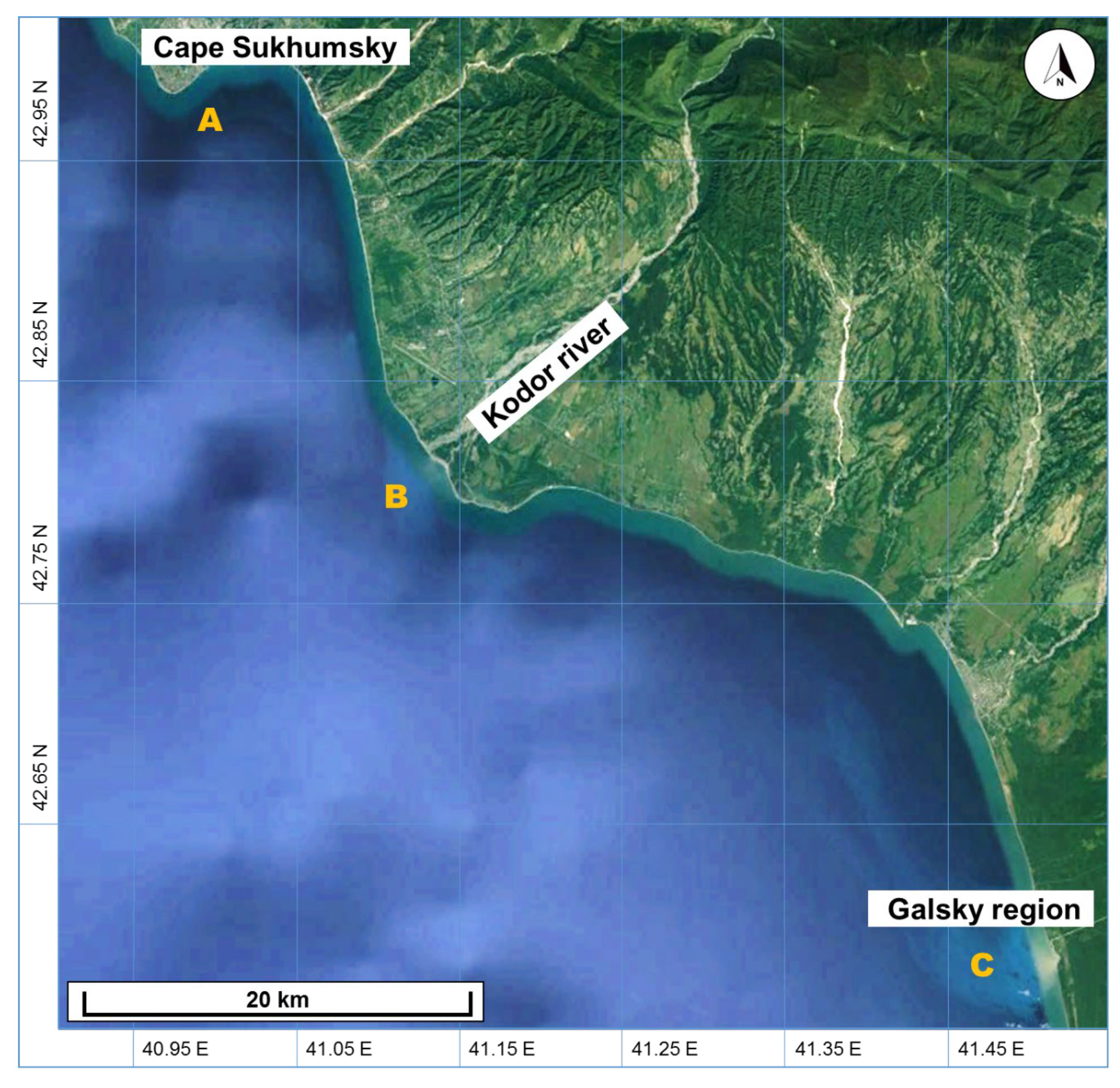



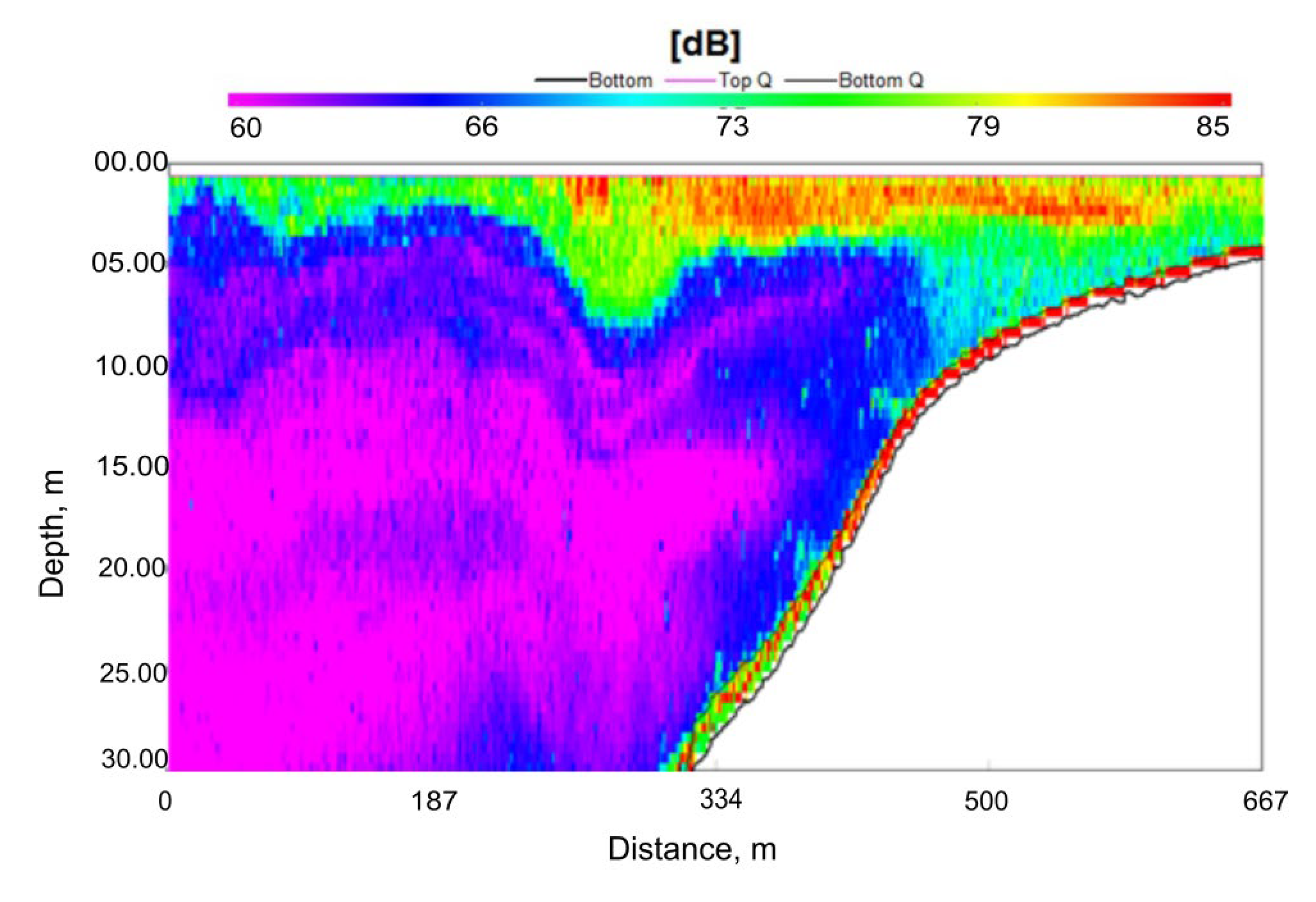
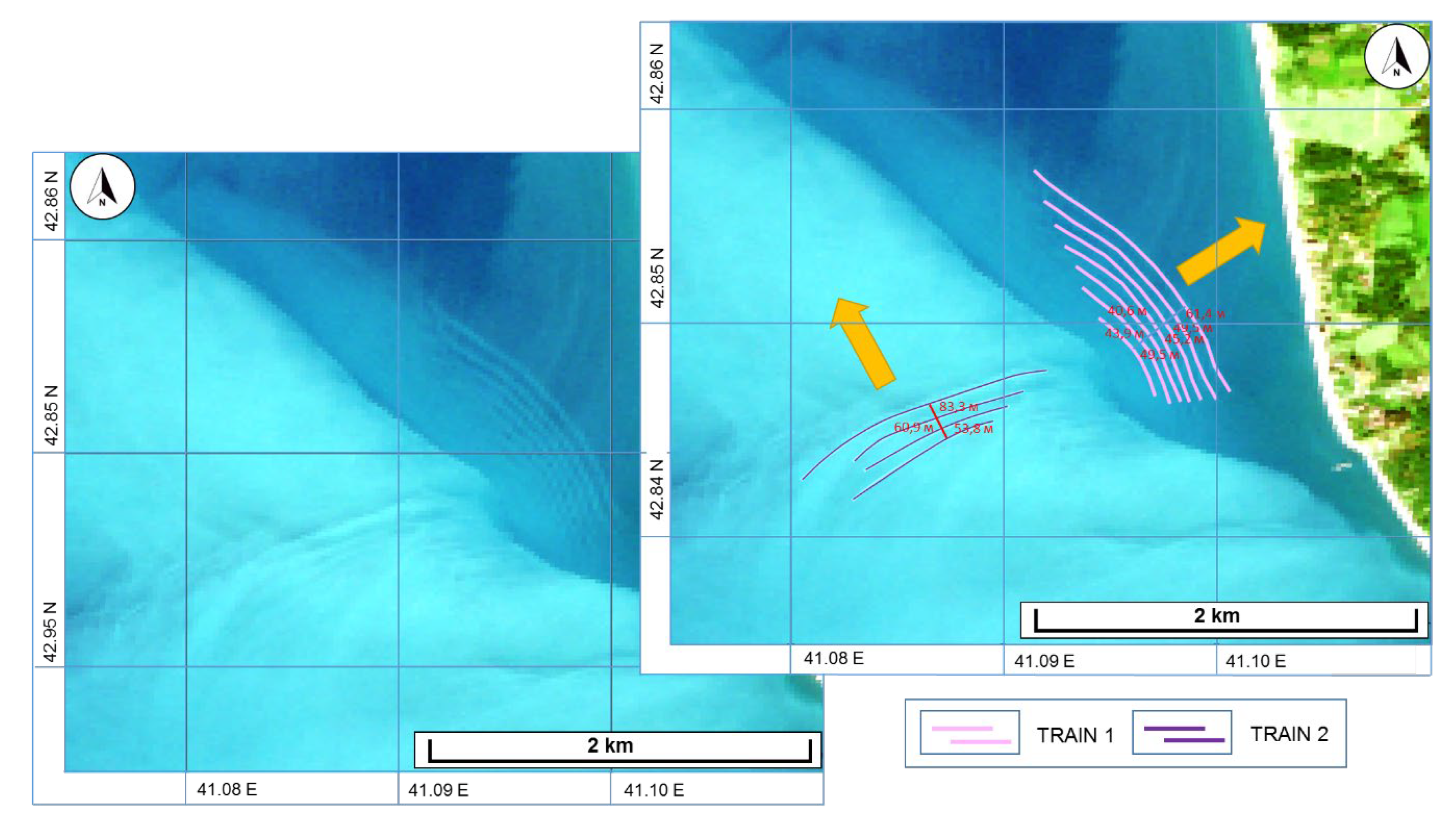


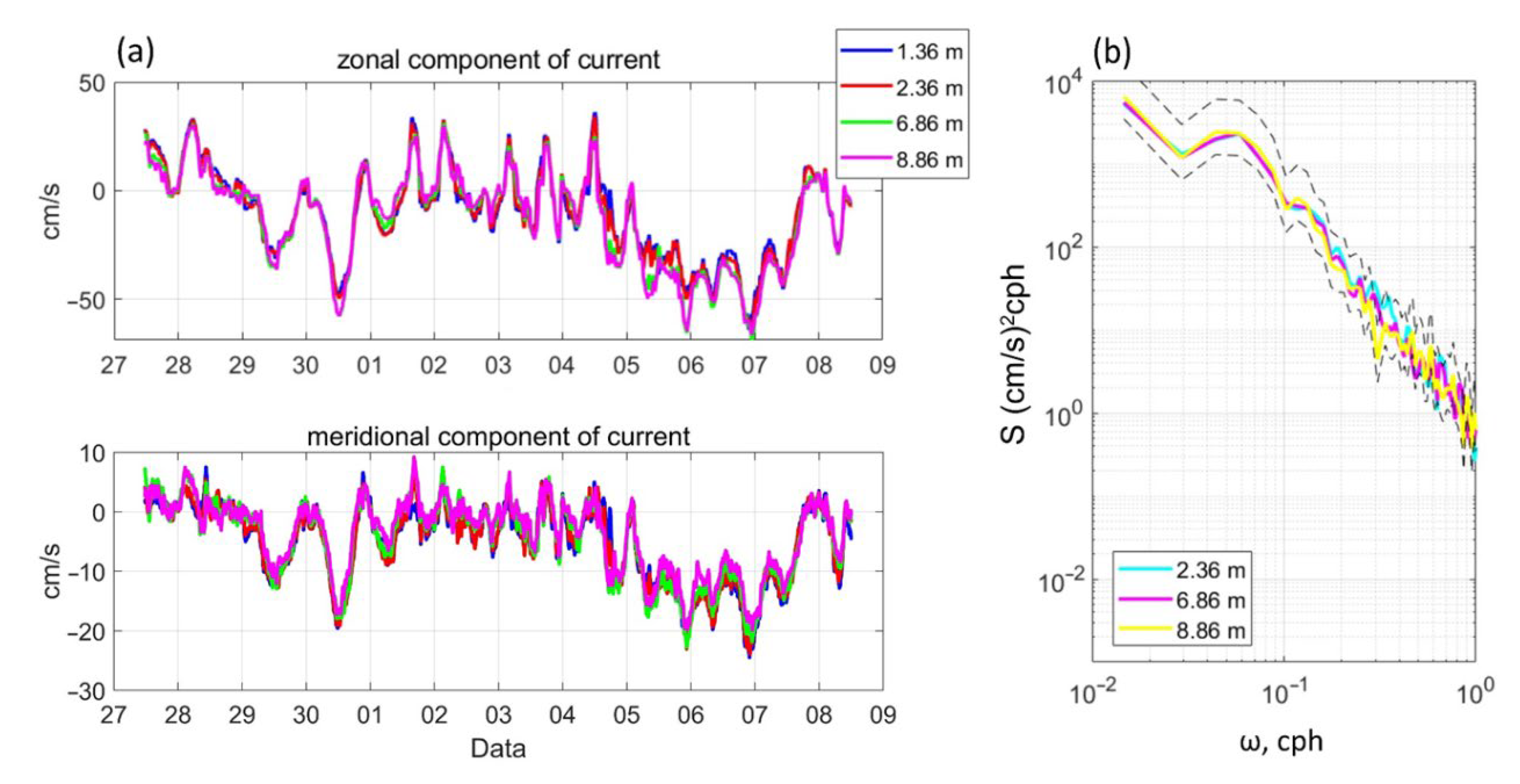

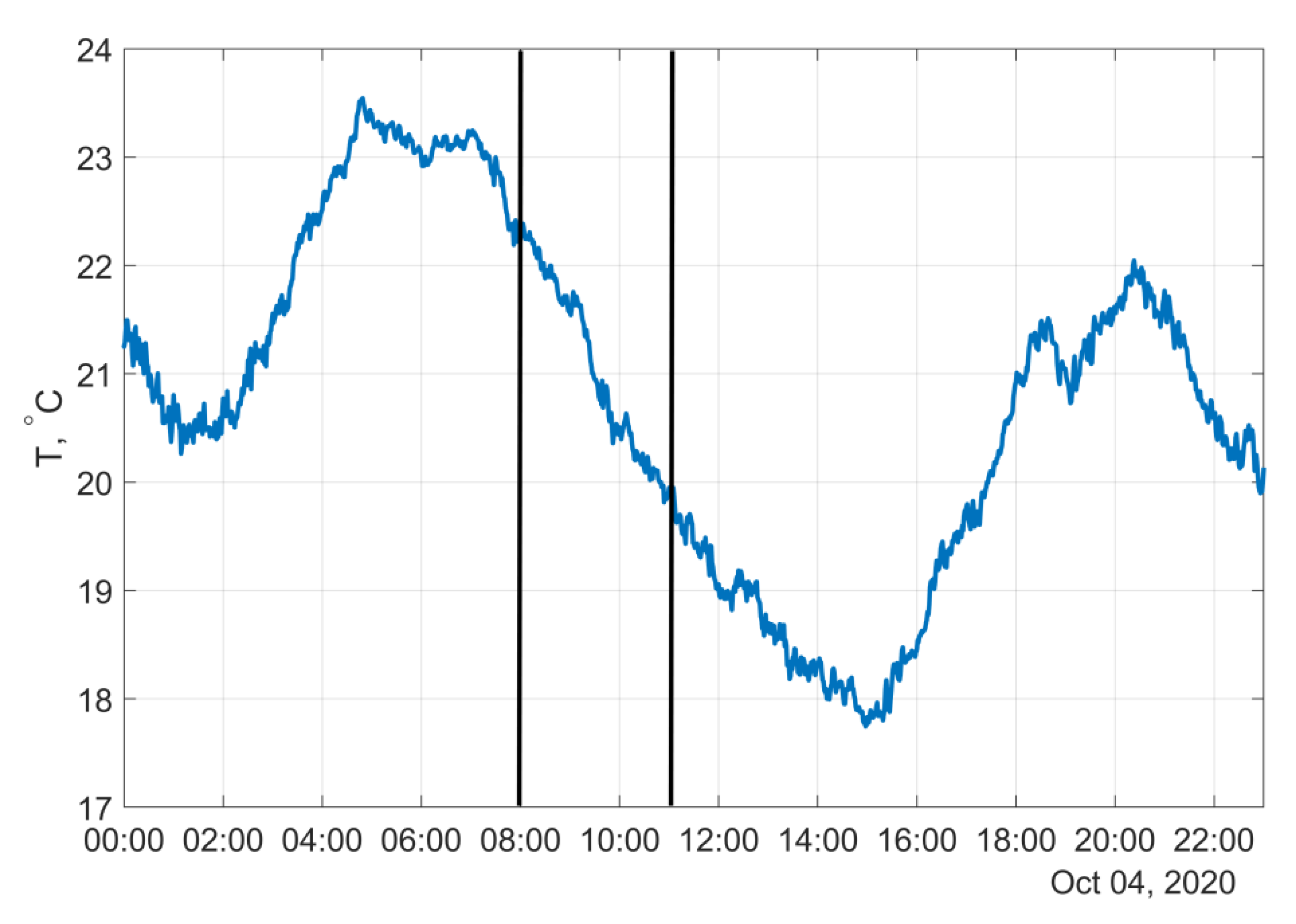
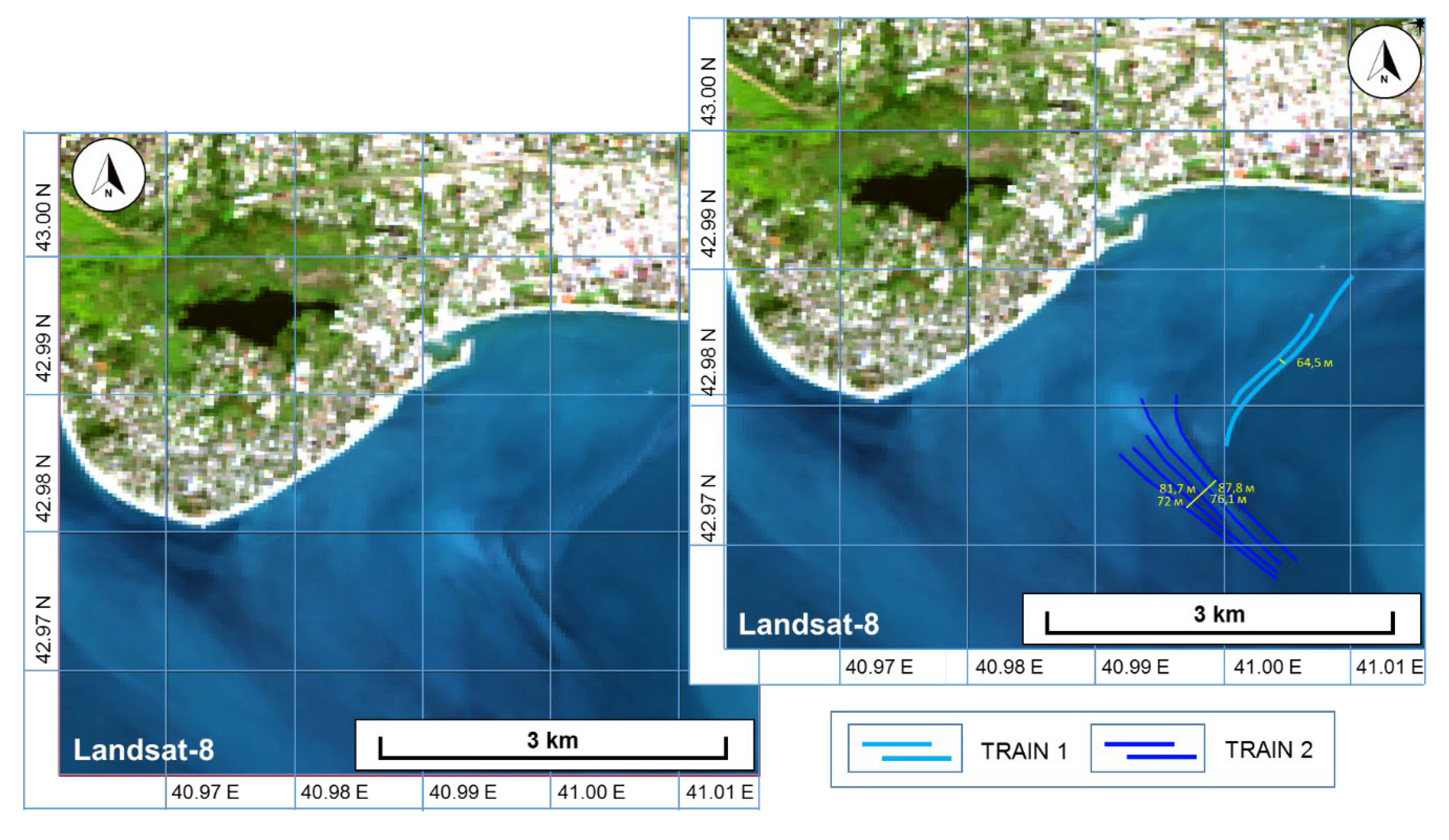
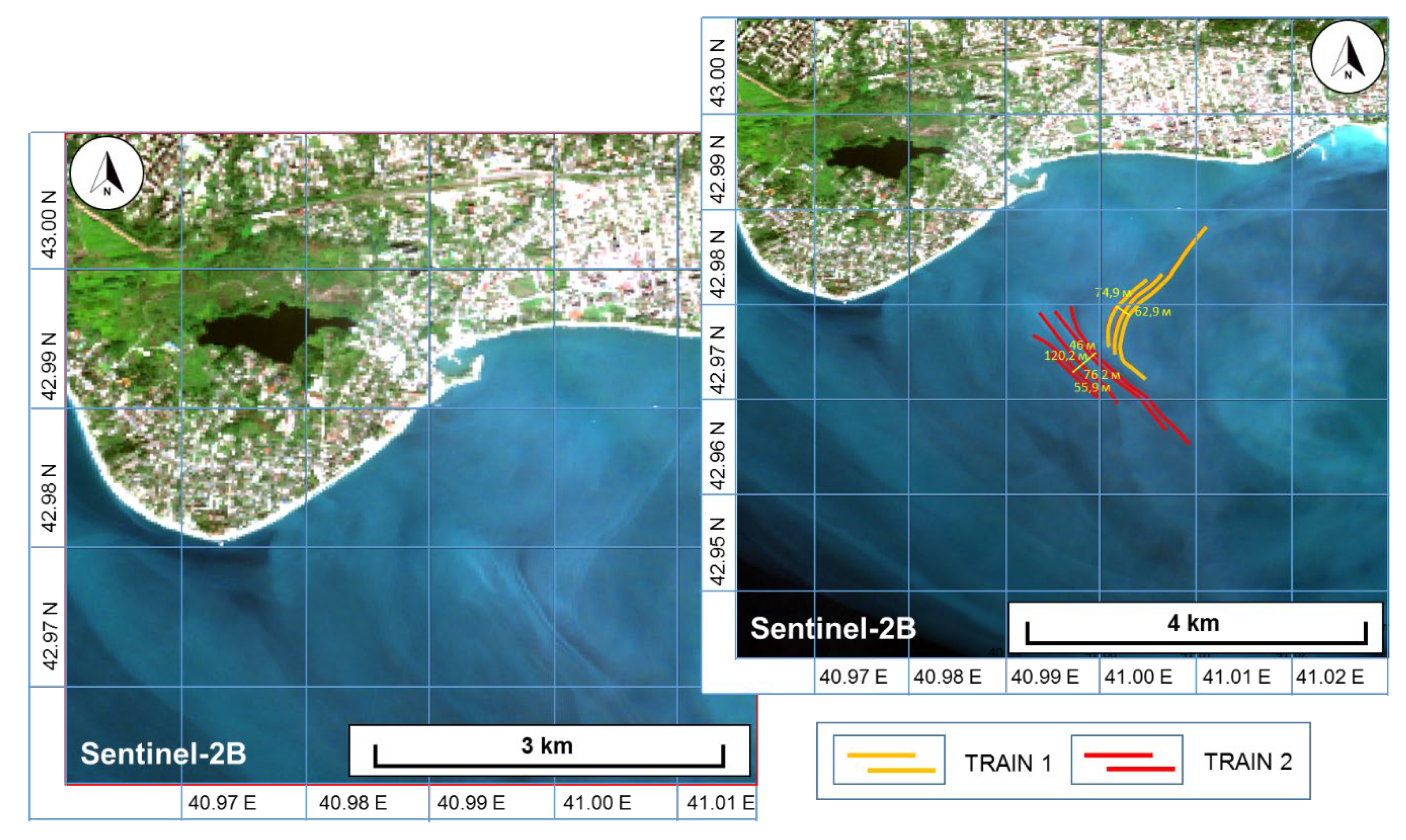

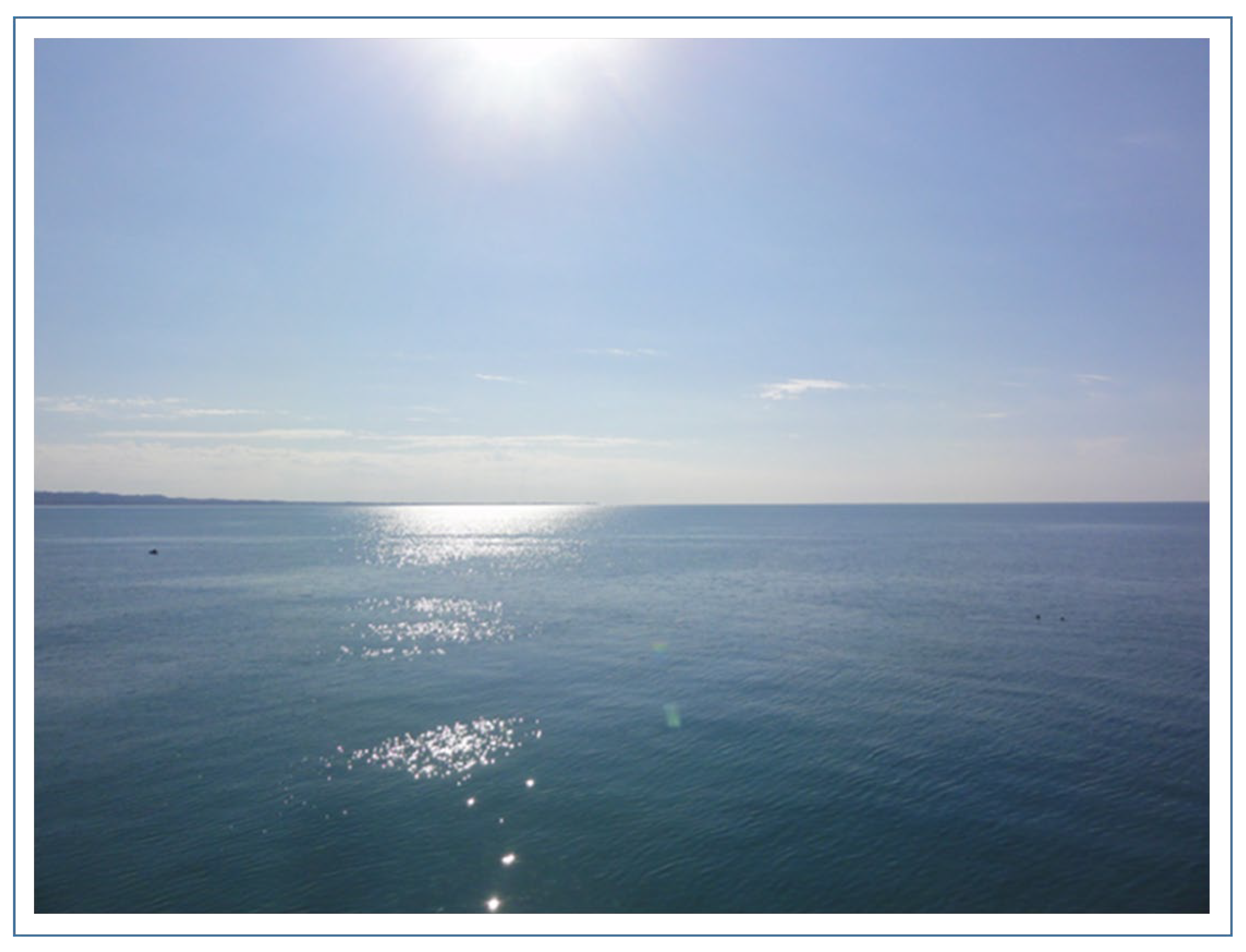

| Landsat-8 | Sentinel-2A/B | |
|---|---|---|
| Sensor, type of source information product | OLI, Collection 1 Tier 1 TOA Reflectance | MSI, Level-1C |
| The channel sequence used | RGB (B4, B3, B2) | |
| Pixel spacing (m) | 30 | 10 |
| Projection used, EPSG | UTM NORTH 37, 32637 | |
| Optimal brightness adjustment | Stretch: “2 sigma” | Stretch: “3 sigma” |
| No. | Date | Satellite | Granule ID |
|---|---|---|---|
| 1 | 10 September 2017 | Sentinel-2 B | 20170910T080959_20170910T081359_T37TFH 20170910T080959_20170910T081359_T37TGH |
| 2 | 4 October 2020 | Landsat-8 | LC08_173030_20201004 LC08_173031_20201004 |
| 3 | 4 October 2020 | Sentinel-2 B | 20201004T080759_20201004T081240_T37TFH 20201004T080759_20201004T081240_T37TGH |
| 4 | 24 October 2020 | Sentinel-2 B | 20201024T081009_20201024T081240_T37TFH 20201024T081009_20201024T081240_T37TGH |
| 5 | 25 August 2021 | Sentinel-2 A | 20210825T080611_20210825T080832_T37TFH 20210825T080611_20210825T080832_T37TGH |
Publisher’s Note: MDPI stays neutral with regard to jurisdictional claims in published maps and institutional affiliations. |
© 2022 by the authors. Licensee MDPI, Basel, Switzerland. This article is an open access article distributed under the terms and conditions of the Creative Commons Attribution (CC BY) license (https://creativecommons.org/licenses/by/4.0/).
Share and Cite
Serebryany, A.; Khimchenko, E.; Zamshin, V.; Popov, O. Features of the Field of Internal Waves on the Abkhazian Shelf of the Black Sea according to Remote Sensing Data and In Situ Measurements. J. Mar. Sci. Eng. 2022, 10, 1342. https://doi.org/10.3390/jmse10101342
Serebryany A, Khimchenko E, Zamshin V, Popov O. Features of the Field of Internal Waves on the Abkhazian Shelf of the Black Sea according to Remote Sensing Data and In Situ Measurements. Journal of Marine Science and Engineering. 2022; 10(10):1342. https://doi.org/10.3390/jmse10101342
Chicago/Turabian StyleSerebryany, Andrey, Elizaveta Khimchenko, Viktor Zamshin, and Oleg Popov. 2022. "Features of the Field of Internal Waves on the Abkhazian Shelf of the Black Sea according to Remote Sensing Data and In Situ Measurements" Journal of Marine Science and Engineering 10, no. 10: 1342. https://doi.org/10.3390/jmse10101342
APA StyleSerebryany, A., Khimchenko, E., Zamshin, V., & Popov, O. (2022). Features of the Field of Internal Waves on the Abkhazian Shelf of the Black Sea according to Remote Sensing Data and In Situ Measurements. Journal of Marine Science and Engineering, 10(10), 1342. https://doi.org/10.3390/jmse10101342








